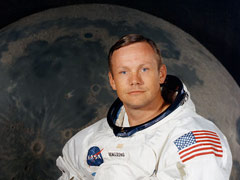AARP Hearing Center
Neil Armstrong: 5 Things You Might Not Know About the First Moonwalker
By Patrick Kiger, August 25, 2012 05:54 PM

If you were around on July 20, 1969, you probably spent that evening as an estimated 500 million others around the world did, eyes glued to our TV screens as we watched astronaut Neil Armstrong climb down from the Apollo 11 lunar module and take the first steps by a human on the surface of the Moon.
And decades later, the words we heard Armstrong utter at that history-making moment - "It's one small step for man, one giant leap for mankind" - still probably send chills down your spine.
Even so, it's odd to think that although we all remember Armstrong, who died today at age 82 in Ohio, we never really knew much about the man who embodied our collective dream of visiting the cosmos. The astronaut seemed to have little interest in his global notoriety, and for decades he fastidiously kept a low profile. After his historic feat, he worked briefly as a NASA administrator, quietly taught aeronautical engineering for a decade at the University of Cincinnati, and then worked for another decade as the chairman of a Virginia-based company that developed aviation software. His lone recent return to the spotlight was a 2010 appearance before Congress, when he protested cuts in the space program.
- Armstrong got his first real glimpse of the Moon as a Boy Scout. As a teenage scout in his hometown of Wapakoneta, Ohio, Armstrong and fellow scouts went to the home of a local engineering draftsman who had installed an eight-inch reflecting telescope, mounted on roller-skate wheels, on the roof of his garage. The amateur astronomer later boasted to newspapers that Armstrong had been so fascinated by what he saw that evening that he had returned numerous times afterward. That actually wasn't true, according to the astronaut's authorized biography, but Armstrong never corrected the story, apparently because he didn't want to embarrass someone from his hometown who'd merely tried to lay claim to a tiny bit of his fame.
- Armstrong had musical chops. In high school, he took up an unusual brass instrument, the baritone horn (a sort of a cross between the trumpet and trombone), because he liked the instrument's distinctive tone. In addition to the school orchestra, he also was in a combo, the Mississippi Moonshiners, which performed Spike Jones tunes at union-hall dances for $5, split four ways. "Neil was a very good musician," one of the other members of the band later told Armstrong's official biographer, James Hanson. "He had a strong after-beat, and he kept us going."
- Armstrong almost didn't make it to the Moon. After accomplishing the first successful docking of two spacecraft in orbit in March 1966, Armstrong's Gemini space capsule began to seriously malfunction, and he and colleague David Scott were ordered to cut short the mission and come home. According to an Associated Press account, they endured some "desperate, fearful moments" before finally splashing down and being rescued by divers.
- Armstrong's famous statement on the Moon actually was different from what we all think we heard. What he actually said was "One small step for a man," which makes a lot more sense logically. In 2006, an Australian researcher analyzed the recording of Armstrong's transmission and discovered that due to limitations of communication technology at the time, a few milliseconds of what the astronaut said had been dropped.
- Spiritually, Armstrong had something in common with Thomas Jefferson. Armstrong marked "no religious preference" on his NASA application, which later led famous American atheist Madalyn Murray O'Hair to claim that he shared her views. According to Hansen's book, however, Armstrong actually considered himself a deist, a person whose faith in God is based on reason rather than religious revelation or the teachings of a particular church.
- Patrick J. Kiger































































